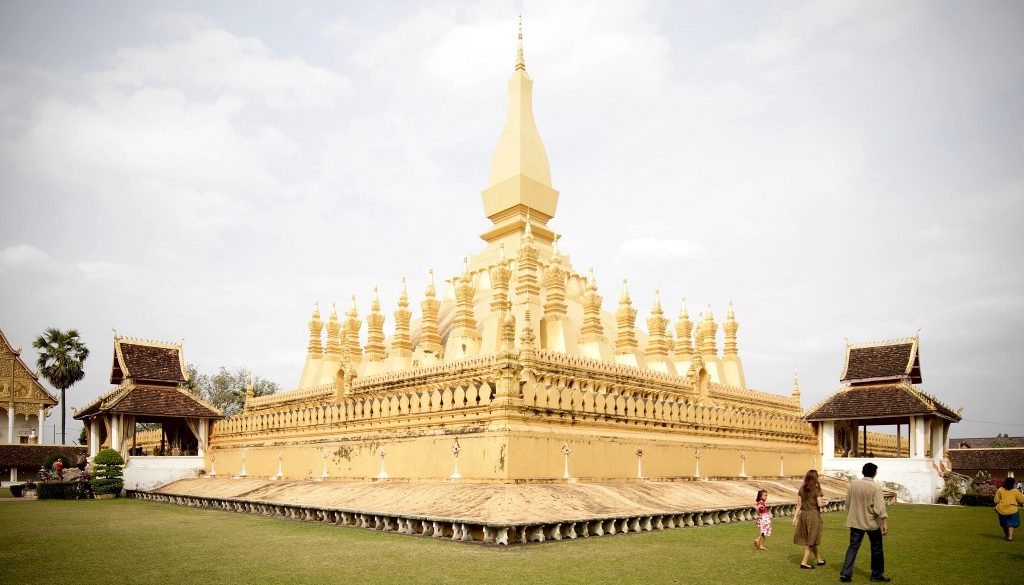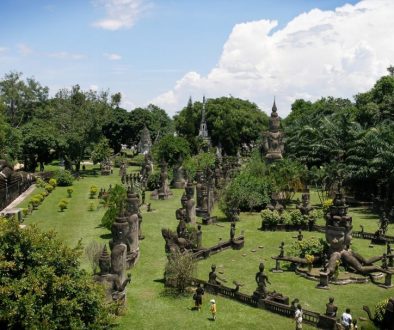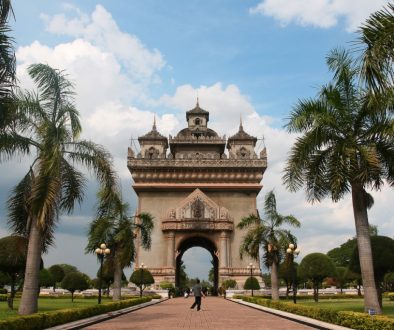Pha That Luang
Pha That Luang is the most important national monument in Laos. This gold-covered stupa sits in the centre of Vientiane and serves as a symbol of Buddhist religion and Lao identity.
While in Laos you’ll see the image of Pha That Luang everywhere. It appears on the money, the nation’s coat of arms, TV station logos and postcards wherever they are sold. As well as being an important symbol for the nation, it’s also the most important religious monument in Laos. So important in fact, it replaced the communist hammer and sickle on the country’s coat of arms.
[themify_box style=”light-yellow note”]
Worth Noting:
- Pha That Luang is 4km from the riverside tourist area
- Entrance fee is 5,000 kip for foreigners
- Grounds close to the public at 4pm
[/themify_box]
A Bit of History
The golden stupa at Pha That Luang was one of the many projects built under King Setthathirat (1534-1571) who established Vientiane as Laos’ capital in 1560. He’s considered one of the great rulers in Lao history for preventing the Lan Xang Kingdom from falling to Burmese domination. His legacy is marked by buddhist monuments throughout the country, including Wat Xieng Thong in Luang Prabang and Pha That Luang in Vientiane.
According to Lao people, the site of Pha That Luang was originally built as a Hindu temple in the 3rd century. It later served as the site of a Khmer temple built in the 13th century which fell into ruins. Over the centuries the site has been plundered repeatedly by Burmese, Siamese and Chinese. A Siamese invasion in 1828 led to massive destruction of Vientiane and virtual abandonment of Pha That Luang. The present structure is a French-directed reconstruction from the 1930s–made to replace an earlier botched French reconstruction in 1900– and is based on the detailed drawings from the late 1860s by the talented French architect and explorer Louis Delaporte.
Getting to Pha That Luang
Pha That Luang is located on a vast open space about 4km from the main riverside area. Surrounded by newer temples on either side, the gilded stupa shines beautifully in the full day sun. Given Vientiane’s hot climate, most visitors will find this a long walk from the river. It is worth traveling there by hired tuk-tuk or rented bicycle. While also spectacular to see and photograph in the late afternoon sun, the shrine itself closes to the public at 4pm. If you arrive late you won’t be able to walk around the inner courtyard, which costs 5,000 kip.
Places Nearby
Pha That Luang is only a kilometre and a half east of Patuxay. Consider visiting both on the same day as they are Vientiane’s most iconic sites. You can very easily walk between the two. If traveling from the riverside area you might consider renting a bicycle for the 4km journey. Vientiane is mostly flat and suitable for bikes. Between Patuxay and Pha That Luang you will pass the Vietnam Embassy, which is in a convenient location for anyone getting visa for Vietnam. Nearby restaurants include Joma Cafe and a Scandinavian Bakery.
Current as of
Photo: Pha That Luang by Motohiro Sunouchi / CC BY 2.0


